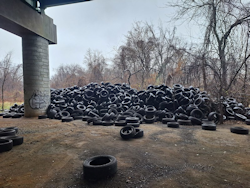SEJournal Online is the digital news magazine of the Society of Environmental Journalists. Learn more about SEJournal Online, including submission, subscription and advertising information.
 |
EJ TransitionWatch: What Will a Second Trump Term Mean for Environmental Justice?
By Joseph A. Davis
Does a second Trump term mean that environmental justice is toast? Yes and no. Well … mostly yes.
Donald Trump and many of the Republicans who support him are implacably hostile to environmental justice as an idea — especially as carried out under President Joe Biden.
While the environmental injustice that originated many decades or centuries ago never really stopped, Biden deserves some credit for his efforts. In response to the young progressives who helped get him elected (e.g., the Sunrise Movement), he rolled out an ambitious environmental justice (EJ) program quickly after taking office.
One keystone was the Justice40
campaign: a ‘whole-of-government’
initiative spanning hundreds of
programs in dozens of agencies.
One keystone of this effort was the Justice40 campaign: a “whole-of-government” initiative spanning hundreds of programs in dozens of agencies. In essence, it sought to ensure that 40 percent of environment-related funds distributed by those agencies would go to disadvantaged communities.
 |
| Discarded tires under an interstate in southeast Washington, D.C., a predominantly Black community that has suffered years of dumping and polluting industry. Photo: GPA Photo Archive, U.S. Department of States/Ward 8 Woods via Flickr Creative Commons (CC BY 2.0). |
Biden also beefed up data tools for determining which communities were underserved and at risk. He called it the Climate and Economic Justice Screening Tool. It was an upgrade of the U.S. Environmental Protection Agency’s EJScreen tool, which had been getting better over many years.
For complex reasons (mainly to avoid lawsuits), it omitted race as a variable — which ended up hurting it politically. We can expect the incoming Trump administration to poleax it.
Biden’s environmental justice achievements were in large part about distributing money. Given a narrowly divided Congress (and the popularity of money), this porky solution worked. Many GOP Congress members attended the resulting ribbon cuttings and took credit for projects they had voted against.
But Biden’s approach didn’t really much change the underlying systemic and institutional racism and injustice that had harmed minorities historically.
The Trump agenda
When Trump says he wants to “Drill, baby, drill,” that’s tough luck for anybody living near an oil refinery.
Still, we can learn more about his agenda by looking at the policy document Project 2025, which Trump has alleged he knew nothing about although he has already absorbed many of its main authors into his transition team (here’s a list).
The Project 2025 document advocates halting “all grants to advocacy groups” — which includes many of the grants going to local environmental justice groups (including some who live near oil refineries). The amount at stake could be several billion dollars.
Project 2025 also calls for the EPA’s Office of Environmental Justice and External Civil Rights to be disbanded and returned to the Office of the Administrator.
All signs are that Trump’s EPA will
deregulate whatever it can. We can
expect it to roll back Biden rollbacks.
All signs are that Trump’s EPA will deregulate whatever it can. His first administration undid some 100 environmental rules. The Biden administration and the courts rolled back many of those rule changes. Now we can expect Trump’s new EPA to roll back Biden rollbacks (may require subscription).
As a result, people who live near oil refineries, or sewage plants, or landfills, or freeways, or fossil power plants, or pipelines, or Superfund hazardous waste sites may be gasping for breath and getting sick more often.
The White House Council on Environmental Quality is another key environmental agency. It coordinates policy among many federal agencies and oversees the National Environmental Policy Act and its mandate to consider the environmental impacts of federal actions. Trump can’t abolish it because it’s mandated by law. But the transition is signaling that he will downsize it.
The underlying problem
The environmental justice problems of the U.S. go back centuries — to the era when Europeans colonized America and took the land from Indigenous people (killing and displacing them and violating treaties). Some small undoing of these injustices did happen under Biden’s Interior Secretary Deb Haaland, the first Native American Cabinet secretary. But many remain.
 |
Those environmental justice problems also go back to 1619, when colonists first brought ashore enslaved Africans. Enslaved people still lacked rights or justice when the U.S. Constitution was adopted in 1789. Even after the Civil War and the 14th Amendment, Black people were still deprived of rights and justice under the Jim Crow system maintained in the South.
Today, the U.S. seems to be rolling back whatever rights came out of the civil rights movement of the 1950s and 1960s.
This history is engraved into the geography and demographics of the U.S. landscape even today. So far, the incoming Trump 2.0 administration seems disinclined to address it.
[Editor’s Note: For more on how the Justice40 program hangs in the balance, read a column from SEJournal’s Voices of Environmental Justice writer Yessenia Funes. And check out our Topics on the Beat page on environmental justice, which includes nearly three dozen helpful stories from SEJournal, along with recent news headlines from EJToday.]
Joseph A. Davis is a freelance writer/editor in Washington, D.C. who has been writing about the environment since 1976. He writes SEJournal Online's TipSheet, Reporter's Toolbox and Issue Backgrounder, and curates SEJ's weekday news headlines service EJToday and @EJTodayNews. Davis also directs SEJ's Freedom of Information Project and writes the WatchDog opinion column.
* From the weekly news magazine SEJournal Online, Vol. 10, No. 1. Content from each new issue of SEJournal Online is available to the public via the SEJournal Online main page. Subscribe to the e-newsletter here. And see past issues of the SEJournal archived here.













 Advertisement
Advertisement 



